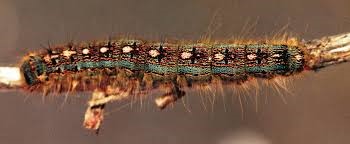All ecosystems have natural pest/pathogen dynamics that evolve alongside host species over ecological time. Under ideal conditions, native pests have controlled population cycles and maintain an equilibrium in their community over time. However, as abiotic conditions shift due to global climate change, native pests and pathogens may lead to more severe damage. Changes in temperature and precipitation, among other factors, can alter the phenological timing of native pests and increase detrimental impacts to trees and forest systems. Monitoring trends in extent and severity of native pest/pathogen disturbance patterns can help anticipate impacts to forests under changing climate conditions. Native pests of concern include: Eastern Spruce Budworm and Forest Tent Caterpillar.
Forest tent caterpillar (FTC) is a pest native to the northeast, with outbreaks happening roughly every 10-15 years and generally lasting 2-4 years. FTC is a defoliator that rarely directly causes tree mortality. However, it does place trees under stress, making them more susceptible to other stressors. Using the 100 years of data aggregated in the FEMC Northeastern Forest Health Atlas we extracted records of damage attributed to FTC across the region and assessed outbreak events using annual forest health reports.

There are too few outbreak events in the historical record to analyze long-term trends, however the number of years between outbreaks has been decreasing over time.
While the total acres damaged by FTC is decreasing over time the percent of those total acres categorized as mortality is increasing significantly.| Data Program | Years | Org | Data Products |
|---|